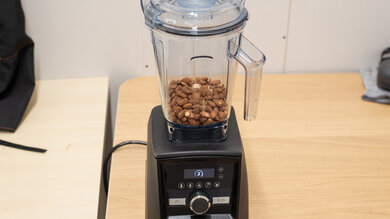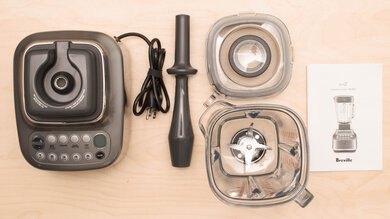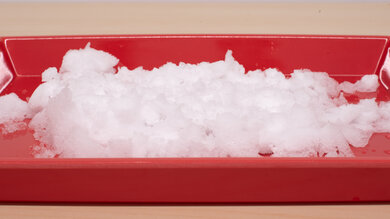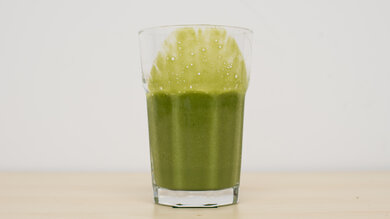
If you like to make frozen drinks and slushies on a hot day, you'll want a blender that can crush ice. However, not all models can blend ice cubes, as ice can sometimes get stuck on the blades, preventing the cubes from breaking down. For a pleasant and tasty drink, most users want a consistent, snow-like blend without any uneven chunks or clumps left behind.
We've tested over 125 blenders, and below are our recommendations for the best blenders for ice crushing you can buy. If you don't find what you need, see our picks for the best blenders for frozen drinks and the best Ninja blenders. If your kitchen needs more than one new appliance, check out our recommendations for the best toasters or the best countertop microwaves.
-
Best Blender For Crushing Ice
Ice Crushing9.6The best blender for crushing ice that we've tested is the Vitamix A3500. Plenty of cheaper options can crush ice just as well, but not many have the same fantastic build quality and versatility. This model can crush a batch of about a dozen ice cubes into snow-like ice in seconds with its 'Frozen Drinks' program. It feels extremely sturdy, which is especially important if you blend a lot of hard ingredients like ice cubes.
It has an equally good performance for other blends. It creates a very smooth blend with fibrous ingredients like fruit and leafy greens, making it a great option for smoothies, and it's quite easy to use for recipes like nut butter as well. Its blending programs make ice crushing easier, but if you don't mind manually pulsing, you might prefer the Vitamix 7500. It's very well-built and makes snow-like crushed ice with its pulse switch. However, it lacks any blending programs and performs worse for some recipes, like single-serve smoothies.
-
Best Upper Mid-Range Blender For Ice Crushing
Ice Crushing9.6If you're looking for an ice crushing blender that still performs well for other recipes, you might prefer the Breville The Q. This full-size blender isn't quite as well-built as the Vitamix A3500, but it's still very sturdy. It quickly makes snow-like crushed ice in its 68oz jar with its ice crush/auto pulse blending program doing all the work. While it's not quite as fast at ice crushing as the A3500, it's still a quick and easy process.
Otherwise, it has a versatile performance. It's an excellent choice for smoothies since it makes a smooth blend with common additions like fruit and leafy greens, although again, it's not as quick as the Vitamix. It's easy to use for thicker recipes, like nut butter or a spoonable smoothie with a lot of frozen fruit or ice. Its jar has a wider base that makes it easier to clean by hand.
-
Best Mid-Range Blender For Ice Crushing
Ice Crushing9.7Consider the Ninja Detect Duo Power Blender Pro if you want something less expensive. This sturdy blender isn't as well-built as the Breville The Q and has a less versatile performance, but it's just as good for ice crushing. It has a pulse mode that can help break up big chunks of ingredients, and you can also use its automatic 'BlendSense' feature for snow-like crushed ice. The 72oz main jar is big enough for multiple servings of slushies or blended margaritas at your next party, and the lid includes a pouring spout, making it easy to serve drinks from the pitcher.
It comes with a pair of 24oz jars, so you don't have to use the big pitcher when blending for one. It makes a very smooth blend with fibrous ingredients in the personal jars, which is important for the silkiest fruit smoothies, and while it makes a less smooth blend in its main pitcher, it still does a good overall job. If you want more personal jars, the Ninja Blender Duo with Auto-iQ BL642 is a very similar blender that comes with three. However, it doesn't blend fibrous ingredients as smoothly, so it's less suitable for fruit smoothies. Both models are more difficult to clean by hand than the Breville, and if you plan to use your blender for a variety of recipes, it's worth noting that you can't use either for hot blending.
-
Best Budget Blender For Ice Crushing
Ice Crushing9.7If you don't plan to use your blender for much besides crushing ice, a straightforward, budget-friendly blender might be just what you need. The Ninja Professional Plus Blender with Auto-iQ is just as good at making snow-like crushed ice as the previous picks, but its lower price comes with a worse performance for other recipes. It only comes with one 72oz jar, but its controls include a button for pulse mode, which can be useful for breaking up bigger chunks of ice, as well as a few automatic blending programs, so you don't have to manually shut off the blender when a recipe is done.
The lid has a pouring spout, which helps with serving drinks directly from the pitcher. However, it doesn't make a completely smooth blend with fibrous fruits and vegetables, which can result in smoothies and blended cocktails having leafy bits or grains leftover. It also has the same blade design as the Ninja Detect Duo Power Blender Pro, which makes it difficult to clean by hand. Still, all of its components are dishwasher-safe. It's also the quietest blender listed here.
-
Best Personal Blender For Ice Crushing
Ice Crushing7.3If you generally blend for just yourself or one other person, you might not want a bulky full-size blender for crushing ice. Personal blenders are smaller, but aren't always suitable for ice crushing. Enter the Ninja Foodi Power Nutri DUO, which has no issue crushing ice in either of its 24oz jars. Its short, compact motor base also makes it easy to store out of the way in a cupboard. It also does a fantastic job of processing fibrous ingredients, so you can use it to make silky single-serve drinks with ingredients like kale. The jars each come with a resealable lid to bring your drink on the go.
It's loud but has a few automatic blending programs, so you can step away from the blender while it's running. It's versatile for a personal blender, thanks to its 14oz 'Smoothie Bowl Maker' that works very well for thick mixtures like nut butter. It's well-built, like the Ninja Professional Plus Blender with Auto-iQ, but it doesn't feel as sturdy as the more expensive blenders on this list. Like most personal blenders, it can't hot blend and has only one speed setting. On the plus side, it's easy to clean by hand, and all the jars, lids, and blade assemblies are dishwasher-safe.
Notable Mentions
- Ninja Foodi Cold & Hot Blender:
The Ninja Foodi Cold & Hot Blender is a fantastic ice crusher, like the Ninja Detect Duo Power Blender Pro, but it has a heating element built into its base that allows it to heat and cook ingredients. This element makes the jar heavier and means you can't immerse it in water for cleaning, but if you're looking for a blender that can handle either hot ingredients or ice cubes, it's a good option.
See our review - Ninja Mega Kitchen System [BL770, BL770AMZ, BL771]:
The Ninja Mega Kitchen System BL770 performs similarly to the Ninja Detect Duo Power Blender Pro for crushing ice in its 72-ounce pitcher. It's more expensive and blends single-serve smoothies more slowly but comes with a food processor, so you might prefer it for that reason.
See our review - Ninja Professional Blender 1000: The Ninja Professional Blender 1000 is a bit cheaper than the Ninja Professional Plus Blender with Auto-iQ. It lacks blending programs but is equally good at ice crushing, so you might prefer it if you want something less expensive and don't mind manually operating the blender. See our review
Recent Updates
-
We've verified that the picks represent the best recommendations and that the products are in stock.
-
We've made minor updates to the text and checked that the products are in stock, but there hasn't been a change to our recommendations.
-
We've replaced the Vitamix 7500 with the Vitamix A3500, since its 'Frozen Drinks' program makes it easier to use for ice crushing. We also replaced the KitchenAid K400 with the Breville The Q, since it offers a better overall blending performance for a similar price.
-
Aug 21, 2024 : We've made minor updates to the text and checked that the products are in stock. However, our recommendations have remained unchanged.
-
Jun 04, 2024 : We've replaced the Ninja Blender Duo with Auto-iQ BL642 with the Ninja Detect Duo Power Blender Pro as the mid-range pick since it's less expensive and performs better for some uses.
All Reviews
Our recommendations above are what we think are currently the best blenders for crushing ice for most people in each price range. We factor in the price (a cheaper blender wins over a pricier one if the difference isn't worth it), feedback from our visitors, and availability (no blenders that are difficult to find or almost out of stock everywhere).
If you would like to choose for yourself, here is the list of all our reviews for blenders for ice-crushing. Be careful not to get too caught up in the details. While no blender is perfect, most blenders are great enough to please almost everyone, and the differences are often not noticeable unless you look for them.
Comments
Best Blenders For Crushing Ice: Main Discussion
What do you think of our picks? Let us know below.
Looking for a personalized buying recommendation from the RTINGS.com experts? Insiders have direct access to buying advice on our insider forum.
Update: We’ve verified that the picks represent the best recommendations and that the products are in stock.
What do you think of these changes? Let us know







































